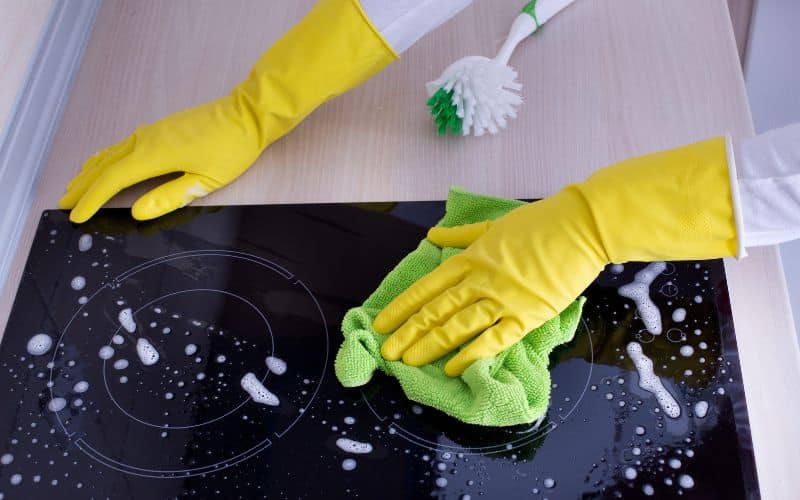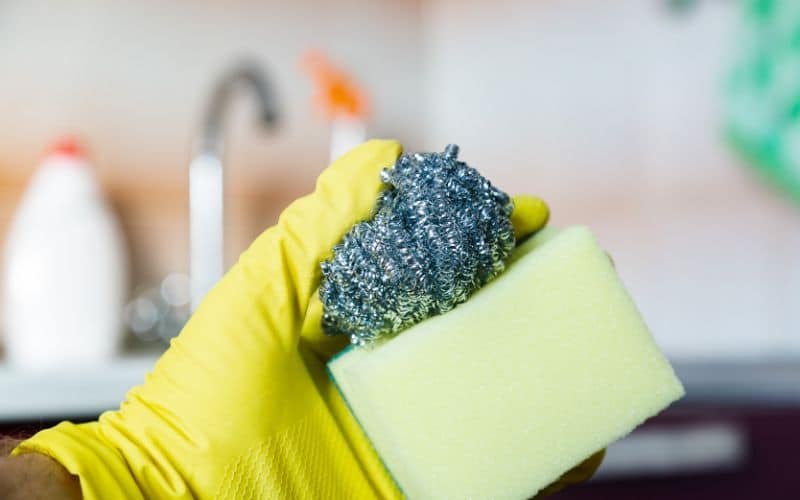Has your electric coil cooktop stove just died and now you’re wondering what type of stove to get next? You’ve probably heard a lot about glass stovetops, as they’re getting increasingly popular, but you’ve probably also heard horror stories about trying to clean them, especially after accidentally burning food on the surface.
Sure, there are pros and cons to whatever type of stove you turn to next, but we guarantee you won’t be the slightest bit disappointed once you receive your glass stovetop. Cleaning it is simple when you follow these tips, or purchase products specific to glass tops. Continue reading to determine if it really will be the right choice for you and how you can keep it looking brand new at all times.
Table of Contents
ToggleWhat Is A Glass Stove?
Unlike the name suggests, the glass stovetop is not just made from 100% glass. Typically, it will be a combination of ceramic and crystalline. The tops are not like your traditional gas top or electric coils. Instead, it’s completely flat.
Though there are certain rules you should follow to extend its life even further, the glass cooktop is widely popular because of its ability to heat up faster, it’s more aesthetically pleasing, and cleaning is relatively easy compared to cleaning around coils.
If you’re running low on space but still want to upgrade your stove, you can also purchase an electric cooktop that fits right on your counter. You’ll still need to be careful as to how you look after it and follow the cleaning instructions, which should come right in the manual.
If you can’t find the manual, however, you can follow these easy steps when it comes to cleaning your glass stovetop.
How To Clean Stove Top Glass

The first step is stocking up on a couple of essential cleaning must-haves like:
- Microfiber cloths
- Magic eraser sponges
- Dish soap
- White vinegar
- A spray bottle
- Weiman glass stove top cleaner
- Baking soda
- A razor blade
- Arm & Hammer toothpaste
- Hydrogen peroxide
We know, the last three sound weird, but they really do work as a glass cleaner, we’re not just pulling your leg. We’ll explain how to use these cleaning products properly below.
Method 1
First of all, before you start cleaning your glass cooktop, make sure it’s cooled down first. Safety first! Plus, if it’s still hot, it can make burns worse if you’re using a glass top stove cleaner.
Once it’s cooled down, you can use a spray bottle with white vinegar and water and use a microfiber cloth to wipe it. Use another clean cloth to dry it. Microfiber cloths are one of the best cloths to use for cleaning because they’re super absorbent and it outlasts other cloths. It can also remove up to 99% of all bacteria on a surface.
If there are still dirt marks or light burn stains, it’s time to use the Weiman glass cleaner. Drizzle some cleaner across the stovetop and let it sit for a couple of minutes. Again, make sure it’s completely cooled down first so the cleaner doesn’t burn too.
Next, use a magic eraser to spread the cleaner around and gently scrub at the burn marks. They should come off no problem. Wipe the top down after with a microfiber cloth to remove any streaks.
Method 2
If the burn marks still aren’t coming off after using the Weiman cleaner, it’s time to bring out the baking soda.
Start out by spraying the glass stovetop with the vinegar and water mixture in a spray bottle. Start soaking a towel in warm water and in the meantime, sprinkle a generous amount of baking soda over the vinegar and glass. Wring out the towel so there’s no water dripping out and cover the entirety of the stove and let it sit for 15 minutes or so.
After removing the towel, wipe the stove down with another clean, dry cloth to get rid of any leftover baking soda and streaks. The burn marks should start to lift but if they’re still being rather stubborn, repeat all the steps again.
Method 3
A razor blade can certainly come in handy for those hard-to-remove burn marks, but you should proceed with caution. Check the manual to see if it advises you against using a razor blade, otherwise, you may want to try this method for getting rid of stubborn grime.
Use the spray bottle with vinegar and water to loosen up the remnants a bit. Use a razor blade to lightly scrape off the residue, but hold it on an angle. It should almost be completely flat.
Don’t use the corners or hold it completely straight as this will scratch the surface. Afterwards, use a microfiber cloth to wipe the surface free of any residue and streaks. You may need to repeat these steps if it’s still not completely clean.
Method 4
If you don’t have a glass cleaner product handy, you can make your own effective cleaning solution. If you have mild dish soap, drizzle it over the glass top. Next, sprinkle baking soda over it mixed with a tablespoon of hydrogen peroxide.
Scrub the solution into the stains with a magic eraser sponge and let it sit for a couple of minutes. Wipe it off with a clean and dry microfiber cloth. If you don’t have hydrogen peroxide handy, you can try using a vinegar and water mixture.
Method 5
If you don’t have hydrogen peroxide or vinegar in your home, yes, you can even try to clean your glass with your Arm & Hammer toothpaste. It seems like a weird way to clean your stove, but it really does work!
Squeeze some of the toothpaste on the burn stains and splatters and use a magic eraser sponge to spread it around. Let it sit on the stains for 15 minutes or so before wiping it off with a damp cloth. Repeat if they’re still being slightly stubborn but are showing signs of weakness!
Cleaning Products To Avoid Damaging Glass Top

If you’re new to the world of owning a glass cooktop, don’t just dive right into trying to clean it without looking up suggestions first or reading the manual. There are things you could be doing that are actually damaging it.
Steel Wool
You’ll want to avoid steel wool completely with your new glass cooktop. It’s not only very abrasive and can leave scratches, but now you’re increasing the amount of food and bacteria that can now get stuck in those scratches. If you have a lot of stains that just aren’t coming out no matter what you do, your best bet is using a razor blade at an angle (so it’s almost flat) to scrape off the stubborn marks.
Wipe Gently
You’re probably desperate to get those unappealing burn marks off your glass top before having guests over, but just like applying too much pressure to a window, your glass stovetop can end up cracking. Using a magic eraser sponge, a razor blade or a microfiber cloth gently should be enough to clean your glass surface efficiently.
Other Glass Stovetop Tips
Because the glass surface can easily be damaged by heavy objects, it’s highly recommended you don’t keep heavy things like pots, plates, cans of food, etc., in the cupboard above the stove. If they accidentally fall out, it could easily crack the glass and even leave a dent.
Another tip, even though it may seem obvious, don’t use cast iron cookware on your glass cooktop. Cast iron has a naturally rough finish and can scratch the glass.
The more scratches that end up in your glass, the more food and bacteria can gather in them and it becomes harder to clean. It’s also very heavy, so if you accidentally dropped the cast iron cookware, the surface can crack. Stainless steel or porcelain cookware is mainly recommended for glass stoves.
Follow These Glass Stovetop Guides
If you follow these simple cleaning methods, your new glass stove will stay in mint condition and never accidentally become damaged!




